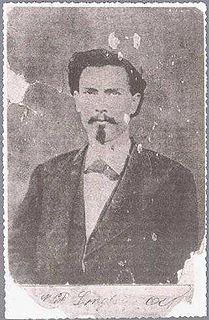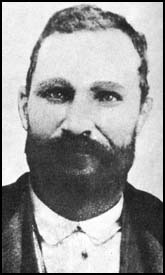Related Research Articles

John HenryHolliday, better known as Doc Holliday, was an American gambler, gunfighter, and dentist. A close friend and associate of lawman Wyatt Earp, Holliday is best known for his role in the events leading up to and following the Gunfight at the O.K. Corral. He developed a reputation as having killed more than a dozen men in various altercations, but modern researchers have concluded that, contrary to popular myth-making, Holliday killed only one to three men. Holliday's colorful life and character have been depicted in many books and portrayed by well-known actors in numerous movies and television series.

John Wesley Hardin was an American Old West outlaw, gunfighter, and controversial folk icon. Hardin often got into trouble with the law from an early age. He killed his first man at the age of 15, claiming he did so in self-defense.

Gunslingers or gunfighters were individuals in the American Old West who gained a reputation of being dangerous with a gun and participated in gunfights and shootouts. Today, the term "gunslinger" is more or less used to denote someone who is quick on the draw with a pistol, but can also refer to riflemen and shotgun messengers. The gunfighter is also one of the most popular characters in the Western genre and has appeared in associated films, video games, and literature.

Robert A. Clay Allison was a cattle rancher, cattle broker, and sometimes gunfighter of the American Old West. He fought for the Confederacy in the Civil War. Allison had a reputation for violence, having survived several one-on-one knife and gunfights, as well as being implicated in a number of vigilante jail break-ins and lynchings. A drunken Allison once rode his horse through town nearly naked—wearing only his gunbelt. Later most reports stated that he was not only dangerous to others but himself, accidentally shooting himself in the foot.

John Peters Ringo, known as Johnny Ringo, was an American Old West outlaw loosely associated with the Cochise County Cowboys in frontier boomtown Tombstone, Arizona Territory. He took part in the Mason County War in Texas during which he committed his first murder. He was arrested and charged with murder. He was affiliated with Cochise County Sheriff Johnny Behan, Ike Clanton, and Frank Stilwell during 1881–1882. He got into a confrontation in Tombstone with Doc Holliday and was suspected by Wyatt Earp of having taken part in the attempted murder of Virgil Earp and the ambush and death of Morgan Earp. Ringo was found dead with a bullet wound to his temple which was ruled a suicide. Modern writers have advanced various theories attributing his death to Wyatt Earp, Doc Holliday, Frank Leslie, and Michael O'Rourke.

William Preston Longley, also known as Wild Bill Longley, was an American Old West outlaw and gunfighter noted for his ruthless nature, speed with a gun, quick temper, and unpredictable demeanor. He is considered to have been one of the deadliest gunfighters in the Old West.

The Life and Legend of Wyatt Earp is the first Western television series written for adults, premiering four days before Gunsmoke on September 6, 1955. Two weeks later came the Clint Walker western Cheyenne. The series is loosely based on the life of frontier marshal Wyatt Earp. The half-hour, black-and-white program aired for six seasons on ABC from 1955 to 1961, with Hugh O'Brian in the title role.

James Brown Miller, also known as "Killin' Jim", "Killer Miller" and "Deacon Jim", was an American outlaw and professional killer of the American Old West, said to have killed 12 people during gunfights. Miller was referred to by some by the alias "Deacon Jim" because he regularly attended the Methodist Church, and he did not smoke or drink. He was lynched in Ada, Oklahoma, in 1909 along with three other men, by a mob of residents angry that he had assassinated a former deputy U.S. marshal.

John Henry Selman was sometimes identified as an outlaw and sometimes a working lawman of the Old West. He is best known as the man who shot John Wesley Hardin in the Acme Saloon in El Paso, Texas, on August 19, 1895.

Ben Thompson was a gunman, gambler, and sometimes lawman of the Old West. He was a contemporary of "Buffalo" Bill Cody, Bat Masterson, John Wesley Hardin, and "Wild Bill" Hickok, some of whom considered him a friend, others an enemy. Thompson fought for the Confederacy during the Civil War, and later for Emperor Maximilian in Mexico. When hired in 1881 as marshal in Austin, Texas, the crime rate reportedly dropped sharply. Thompson was murdered at the age of 40 in San Antonio, Texas, in the "Vaudeville Theater Ambush."

Echo Burning is the fifth novel in the Jack Reacher series written by Lee Child. It was published in 2001 by Putnam in America and Bantam in the United Kingdom. It is written in the third person.

Jesse Evans was an American outlaw and gunman of the Old West, and leader of the Jesse Evans Gang. He received some attention due to his disappearance in 1882, after which he was never seen or heard from again, and is now presumably deceased.
John Pinckney Calhoun Higgins, better known as "Pink" Higgins, was a gunman and cowboy of the Old West. He is known to have killed 14 men in his lifetime.

The Clifton House was an important overnight stage stop on the Mountain Branch of the Santa Fe Trail. It was located in Colfax County, New Mexico about six miles south of Raton, New Mexico, on the Canadian River. The site is located at mile marker 344 of U.S. Route 64, just off of exit 446 on Interstate 25.

Feuds in the United States deals with the phenomena of historic blood feuding in the United States. These feuds have been numerous and some became quite vicious. Often, a conflict which may have started out as a rivalry between two individuals or families became further escalated into a clan-wide feud or a range war, involving dozens—or even hundreds—of participants. Below are listed some of the most notable blood feuds in United States history, most of which occurred in the Old West.
Davy Crockett was an American outlaw and a younger relative of the famed frontiersman of the same name, Davy Crockett.
The Sutton–Taylor feud began as a county law enforcement issue between relatives of a Texas state law agent, Creed Taylor, and a local law enforcement officer, William Sutton, in DeWitt County, Texas. The feud cost at least 35 lives and eventually included the outlaw John Wesley Hardin as one of its participants. It began in March 1868, not reaching its conclusion until the Texas Rangers put a stop to the fighting in December 1876.

The Colfax County War was a range war that occurred from 1873 to 1888 between settlers and the new owners of the Maxwell Land Grant in Colfax County, in the U.S. state of New Mexico. The war started when the new landowners tried to remove the local settlers from the land they had just bought. The locals refused to leave, as they had settled much of their livelihood in the grant, which resulted in conflict and violence in 1875.
Hugh Anderson was a cowboy and gunfighter who participated in the infamous Gunfight at Hide Park on August 19, 1871, in Newton, Kansas. Prior to the gunfight, Anderson was a son of a wealthy Bell County, Texas cattle rancher who drove from Salado, Texas to Newton. Anderson was the one who led the cowboy faction during the gunfight, and was also one of the first to draw blood.
References
- ↑ "Clay Allison - Gunfighter". Archived from the original on 2011-07-12. Retrieved 2011-03-15.